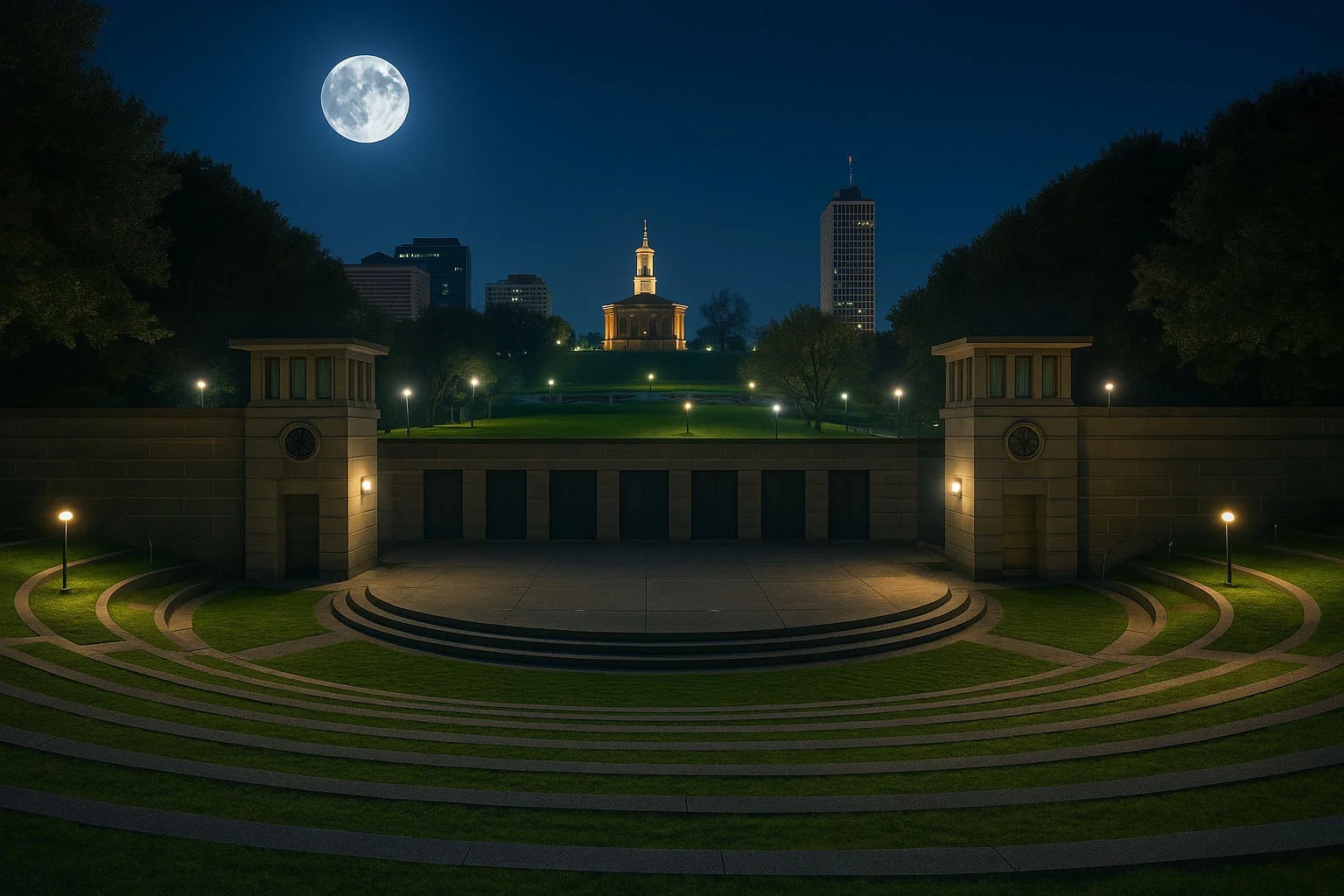Today's Bicentennial Park, bounded by James Robertson Parkway, 6th Avenue, and the Cumberland River, is a pleasant urban oasis. But from the 1860s through the early 1900s, this area was Smokey Row—a collection of seedy saloons, brothels, gambling dens, and opium houses that catered to riverboat workers, soldiers, criminals, and men seeking vice. The district earned its name from the constant smoke that hung over the area from coal stoves, cigars, and opium pipes. It was a place where women were exploited, lives were destroyed, and violence was commonplace. Despite urban renewal efforts that demolished the physical structures, many believe the spiritual residue of Smokey Row's suffering cannot be erased.
The Rise of Smokey Row
Smokey Row emerged during the Civil War when Nashville became a major Union occupation center. Thousands of soldiers, camp followers, and opportunists flooded the city. The area near the riverfront, conveniently close to the wharves where riverboats docked, quickly became a center for prostitution and vice. After the war, rather than disappearing, Smokey Row expanded.
By the 1870s and 1880s, the district was fully established with dozens of brothels, saloons, and gambling houses operating openly. Nashville authorities largely tolerated the area, seeing it as a way to contain vice in one district rather than have it spread throughout the city. Women worked in the brothels—some by choice, many coerced or trapped by circumstance, poverty, or addiction. Violence was common, with fights, murders, and 'accidental' deaths occurring regularly. Disease, particularly venereal disease and tuberculosis, ran rampant.
Life and Death in the District
Life in Smokey Row was brutal, especially for the women who worked there. Many were young—some as young as 14 or 15—and few lived past their 30s. They faced violence from customers, madams, and pimps. Unwanted pregnancies were common, with primitive and often deadly abortion attempts. Drug addiction, particularly to laudanum and opium, was epidemic. When women became too sick, too old, or too addicted to work, they were often simply cast out onto the streets to die.
Murders in Smokey Row were frequent but rarely investigated thoroughly. A dead prostitute found in an alley was considered unfortunate but not worthy of serious police resources. Many women simply disappeared, their bodies dumped in the river or buried in unmarked graves. Some estimates suggest hundreds of women died in Smokey Row, most never identified, never mourned, and quickly forgotten by a society that had already discarded them.
The End of Smokey Row
By the early 1900s, progressive reformers and religious groups began campaigning to clean up Nashville. Smokey Row became a primary target. In 1916, Tennessee passed legislation aimed at closing red-light districts statewide. Over the next decade, Smokey Row was gradually shut down. The buildings were demolished, and the area fell into industrial use and eventually abandonment.
When Nashville's Bicentennial Park was planned in the 1990s, the land was cleared and transformed into the green space that exists today. But construction workers reported strange occurrences during the building process—unexplained cold spots, the sensation of being watched, tools that moved on their own, and some claimed to see shadowy figures among the construction equipment at night. Some workers refused to work certain areas, saying the ground felt 'wrong' or 'angry.'
The Woman in Red
The most frequently reported apparition in Bicentennial Park is a woman in a red dress from the late 1800s, seen walking the paths or standing near the river overlook. Witnesses describe her as young—appearing to be in her early 20s—with dark hair and a sad, distant expression. She wears a red Victorian-era dress that would have been typical of a Smokey Row prostitute trying to attract customers.
Those who have encountered her report:
- She appears solid and real until approached, then fades away
- She often seems to be looking for something or someone
- Some witnesses report hearing her crying softly
- She's most frequently seen at dusk or after dark
- The temperature drops noticeably when she appears
- A few witnesses report she has bruises visible on her face and arms
One park visitor reported: 'I saw this woman in old-fashioned clothes standing by the walkway. I thought she was a reenactor or something. When I got closer to ask about her costume, she just vanished. Not walked away—vanished. I ran out of that park and didn't come back for months.'
The Murdered Girl
Security guards and late-night joggers have reported encountering the spirit of a young girl, estimated to be in her mid-teens, who appears terrified and desperate. Unlike the Woman in Red, who seems melancholic, this spirit appears to be in active distress, as if reliving her final moments.
Encounters include:
- A young girl in tattered clothing running through the park as if fleeing from someone
- Hearing screams and cries for help with no visible source
- Finding areas of disturbed grass or dirt where witnesses swear they saw someone struggling moments before
- The overwhelming sensation of fear and panic in certain spots in the park
- Some witnesses report seeing a man chasing her before both figures vanish
Paranormal researchers believe this may be the spirit of a young prostitute who was murdered in Smokey Row, possibly as young as 14 or 15, still running from the killer who took her life over a century ago. The fact that she appears to be reliving her death suggests a residual haunting—her terror so intense that it imprinted permanently on the location.
Shadow Figures and Threatening Presences
Visitors to Bicentennial Park, particularly after dark, frequently report seeing shadow figures—dark, human-shaped silhouettes that move deliberately through the park. Unlike the identifiable female spirits, these shadows feel aggressive and threatening. Many witnesses believe these are the spirits of Smokey Row's violent men—customers who murdered prostitutes, criminals, and others who committed acts of violence in the district.
Reports include:
- Dark figures following people through the park
- Feeling physically pushed or grabbed by unseen hands
- A sense of being hunted or stalked
- Sudden, overwhelming aggression or anger with no apparent cause
- The smell of cigar smoke, whiskey, and unwashed bodies
- Hearing male voices arguing or threatening violence
- Some female visitors report feeling specifically targeted or threatened
Park rangers have noted that certain areas of the park see higher incident reports of people feeling uncomfortable or unsafe, even when no living person is present. Some believe these aggressive spirits continue to prey on visitors, just as they preyed on Smokey Row's vulnerable population in life.
The Children's Voices
One of the most heartbreaking paranormal phenomena in Bicentennial Park is the sound of children crying or playing, heard when no children are present. Smokey Row was home not just to prostitutes but also to their children—babies and young kids who grew up surrounded by vice, violence, and disease. Many died young from neglect, disease, or violence. Some were born addicted to laudanum or other drugs their mothers used. Few were given proper burials or even names.
Witnesses report:
- The sound of babies crying, particularly near the river overlook
- Children laughing or playing when the park is empty
- Small handprints appearing on windows or surfaces
- The sensation of a small hand taking theirs
- Toys or objects moved when no one is around
- Some sensitive visitors report feeling overwhelmed with sadness for 'forgotten children'
Unlike the more frightening encounters with adult spirits, witnesses describe the children's spirits as sad rather than scary—lost souls who died without ever experiencing real childhood, still seeking the love and safety they never had in life.
Residual Hauntings
Beyond individual spirit sightings, Bicentennial Park experiences what paranormal investigators call residual hauntings—psychic impressions of past events that replay like recordings. These aren't intelligent spirits but rather emotional and sensory echoes of Smokey Row's history.
Visitors report:
- Hearing piano music from saloons that no longer exist
- The smell of cheap perfume, cigar smoke, and opium
- Sounds of laughter, arguing, and screaming with no source
- The sensation of walking into a building when in the middle of an open space
- Feeling suddenly drunk or disoriented in certain areas
- Some report experiencing flashes of scenes from Smokey Row—seeing the old buildings superimposed over the modern park for brief moments
These residual hauntings suggest that the decades of intense emotion—lust, desperation, violence, addiction, and death—have permanently imprinted on the land itself. The park may look modern and peaceful, but psychically, Smokey Row has never truly been demolished.
The River Spirits
The Cumberland River borders Bicentennial Park, and during Smokey Row's heyday, the river was often used to dispose of bodies—murdered prostitutes, unwanted babies, and others who died in the district. Some estimate dozens of bodies were thrown into the river, most never recovered or identified.
Near the river overlook and riverside paths, witnesses report:
- Seeing figures standing at the water's edge before disappearing
- Hearing splashing sounds followed by cries for help
- The sensation of being pulled toward the water
- Seeing what appears to be bodies floating in the river that vanish upon closer inspection
- An overwhelming sense of drowning or suffocation near certain spots along the riverbank
- Some witnesses report seeing ghostly lights hovering over the water
Paranormal investigators believe these are the spirits of those whose bodies were dumped in the Cumberland, either calling for help or eternally reliving their final moments of terror as they drowned.
Visiting Bicentennial Park
Bicentennial Park is a public park in downtown Nashville, open daily from dawn to dusk. The park features walking paths, monuments, and green spaces. While it appears peaceful during the day, those interested in the paranormal find it takes on a different atmosphere after dark.
For those interested in the haunted history:
- Evening hours, particularly around dusk, see the most paranormal activity
- The area near the river overlook is particularly active
- Certain pathways, especially those that would have been main streets in Smokey Row, experience more phenomena
- Be respectful—these are believed to be the spirits of real people who suffered greatly
- Some local ghost tours include the park on their routes
- Bring recording equipment—EVP sessions have captured voices and sounds
Important notes:
- The park is well-lit and generally safe, but exercise normal urban caution after dark
- Park rules prohibit overnight stays
- Be respectful of other park users and the spirits
- If you feel uncomfortable or threatened, leave immediately
Bicentennial Park stands as a reminder that beautiful modern spaces can be built over dark histories, but the past cannot always be paved over. The spirits of Smokey Row refuse to be forgotten, ensuring that the suffering, exploitation, and tragedy that occurred here will be remembered—even if only through ghostly encounters that remind us of lives that were lived, lost, and discarded in Nashville's most notorious district.

Where Smokey Row's spirits still walk after dark

Where bodies were once disposed of and spirits still cry for help

